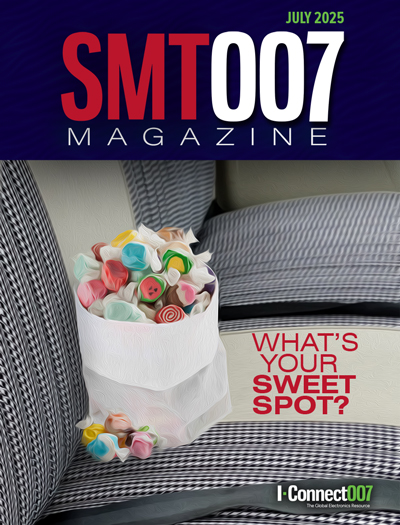-

- News
- Books
Featured Books
- smt007 Magazine
Latest Issues
Current Issue
Supply Chain Strategies
A successful brand is built on strong customer relationships—anchored by a well-orchestrated supply chain at its core. This month, we look at how managing your supply chain directly influences customer perception.

What's Your Sweet Spot?
Are you in a niche that’s growing or shrinking? Is it time to reassess and refocus? We spotlight companies thriving by redefining or reinforcing their niche. What are their insights?

Moving Forward With Confidence
In this issue, we focus on sales and quoting, workforce training, new IPC leadership in the U.S. and Canada, the effects of tariffs, CFX standards, and much more—all designed to provide perspective as you move through the cloud bank of today's shifting economic market.
- Articles
- Columns
- Links
- Media kit
||| MENU - smt007 Magazine
Material Effects of Laser Energy When Processing Circuit Board Substrates During Depaneling
July 27, 2016 | Ahne Oosterhof, LPKF Laser & Electronics North AmericaEstimated reading time: 13 minutes
Additional EDX probing was done on cut walls of boards with different thicknesses and with differences in laser system setups. From those, ones were selected for an 800 µm board (33 mil) cut with setup conditions as in Table 1 and comparing those to a cut made in a similar board which was depaneled with a router.
A finely focused beam was used to be able to measure the chemical components on the epoxy and also on the glass fibers. In the tests, probes 3 and 4 are done with different cooling (or rest) times between passes thereby allowing the surface to remain cooler.
Table 1. Comparison between cut walls of boards with setup conditions and boards depaneled with a router.
Figure 16: Inspecting epoxy areas.
Figure 17: EDX analysis epoxy area.
Figure 18: Inspecting surface of glass fibers.
Figure 19: EDX analysis on glass area.
Figure 17 shows that with shorter cooling times a slightly higher amount of carbon and oxygen are present.
For probes 5 and 6 the cutting speed was changed significantly, which means that with the slower speed a complete cut is obtained with fewer repetitions. With the higher cutting speed more carbon and less oxygen remains present.
All the tests were compared to a routed side wall where in each case more carbon was present there while the amount of oxygen did not vary significantly.
The chemical element that would raise most concern is carbon, yet in all these laser cut cases, the presence of this element is lower or at most similar to that in the routed board.
Conclusions
Using a laser for depaneling can have significant economic advantages because more boards can be placed on the same panel. But also one can expect better long-term reliability as the board’s edges are not exposed to bending strain when breaking the last connecting points to the panel.
In addition, the board edges are not seeing high levels of compression when they are being cut. The panels retain their original rigidity during assembly which may make it possible to work without pallets.
Page 5 of 6
Testimonial
"Advertising in PCB007 Magazine has been a great way to showcase our bare board testers to the right audience. The I-Connect007 team makes the process smooth and professional. We’re proud to be featured in such a trusted publication."
Klaus Koziol - atgSuggested Items
LPKF Increases Revenue in the 1H of 2025 Despite global uncertainties
07/24/2025 | LPKFThe LPKF Group increased revenue by 7.2% to EUR 59.2 million in the first half of 2025 and achieved an almost balanced adjusted EBIT* (earnings before interest and taxes) of EUR -0.7 million.
Altus, Danutek Expand Partnership with LPKF to Offer Laser Plastic Welding Solutions
05/21/2025 | Altus GroupAltus Group, a leading supplier of capital equipment and service support for the electronics manufacturing sector in the UK and Ireland, and its sister company Danutek, which serves Central and Eastern Europe, are expanding their technology offering through an enhanced partnership with LPKF, a specialist in laser-based manufacturing solutions.
LPKF Reports Results for Full Year 2024
03/27/2025 | LPKFThe technology company LPKF Laser & Electronics SE published today its annual report for 2024. Despite the challenging economic conditions for the German mechanical engineering industry, LPKF was able to maintain its revenue slightly below the previous year's level at EUR 122.9 million.
Queen's University Belfast Enhances RF Research with LPKF ProtoLaser R4
03/26/2025 | LPKFThe Centre for Wireless Innovation (CWI) at Queen's University Belfast relies on the state-of-the-art LPKF ProtoLaser R4 to conduct RF research with high-precision structuring of sensitive materials.
Real Time with... IPC APEX EXPO 2025: LPKF's Advancements in Laser Depaneling Technology
03/25/2025 | Real Time with...IPC APEX EXPOIn this recent interview, Jake Benz from LPKF Laser and Electronics discusses advancements in laser depaneling technology, focusing on speed and quality. He highlights the previous negative reputation of laser depaneling and shares insights from nearly two decades of experience. As customer needs evolve, traditional companies are exploring laser technology.


